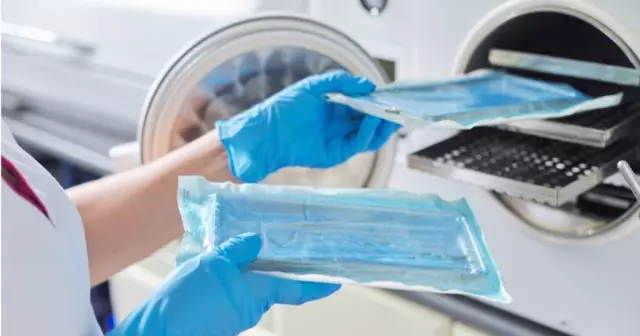- Author Curtis Blomfield [email protected].
- Public 2023-12-16 20:44.
- Last modified 2025-01-23 17:01.
Disinfection (French des - I eliminate and Latin infection - infection) is one of the main methods of destruction of microorganisms in the external environment, including especially dangerous and pathogenic ones.
If we consider the epidemic process as a chain, the first link in it will be sick people and animals that are the source

infections and for which therapeutic measures are being applied.
The second link in the spread of infection is the factors of transmission of infection, which include premises where the sick are kept, items of care and maintenance for the sick, including dishes, inventory, overalls, tools, etc.
Disinfection and sterilization are just the main operating forces aimed at the second link in the epidemic chain.
Sterilization and disinfection involve the same action - the elimination of microorganisms or toxins, but the essence of these concepts is different. Disinfection involves the destruction of the bulk of the pathogen. Before her

application always takes into account the specific type of pathogen that will be targeted, as well as the composition of the disinfectant that will have the highest effect.
Under the concept of "sterilization" is understood the complete elimination of microorganisms, both causing an infectious process and not causing it. The types of sterilization are very diverse, but they are carried out in small areas or on small objects, and only when there is a momentary need for them. In other words, sterilization cannot be used for planned or preventive purposes. Disinfection is one of the main activities carried out just for preventive, he alth-improving or planned purposes. Consequently, the classification of disinfection measures is much broader than sterilization measures, and all of its types have a more diverse application.
Disinfection and sterilization have many methods. Moreover, there are much fewer sterilization ones than disinfection ones.
The main methods of sterilization are autoclaving, boiling, exposure to some chemicals, heating with dry heat sources, ultraviolet irradiation and some others. The purpose of sterilization is one - the complete destruction of microorganisms.
There are many more disinfection methods, and most of them are of a larger scale, although they do not guarantee the complete destruction of the pathogen

microflora.
Can disinfection and sterilization, acting together, reliably protect people and animals from especially dangerousdiseases that still occur in our lives? The answer, of course, is no.
Disinfection measures against anthrax, suppose, it is impossible to achieve 100% destruction of the pathogen in the external environment, no matter what methods this event is carried out. Sterilization, on the other hand, is mainly aimed at small objects and, in its essence, guarantees the destruction of any kind of infectious agents, even such dangerous and resistant ones as anthrax microbial bacilli and their spores, but only on small objects that will not play a role in liquidation measures.
And yet the fight against infections should be carried out in a comprehensive manner, both disinfection and sterilization must be involved in such activities. Excluding at least one of them from the list, it will be simply impossible to achieve positive results in the fight against most diseases.






